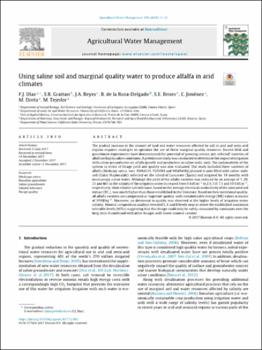Using saline soil and marginal quality water to produce alfalfa in arid climates
Fecha
2018Resumen
The gradual increase in the amount of land and water resources affected by salt in arid and semi-arid regions requires strategies to optimize the use of these marginal-quality resources. Recent field and greenhouse experiments have demonstrated the potential of growing certain ‘pre-selected’ varieties of
alfalfa inhighly saline conditions.Agreenhouse study was conductedtodetermine the impact ofirrigation with saline groundwater on alfalfa growth and production in saline-sodic soils. The sustainability of the system in terms of forage yield and quality was also evaluated. The study included three varieties of alfalfa (Medicago sativa, vars. SW8421S, PGI908S and WL656HQ) planted in pots filled with saline-sodic soil (Calcic Haplosalids) collected on the island of Lanzarote (Spain) and irrigated for 18 months with increasingly saline water. Although the yield of the alfalfa varieties was reduced by an average of 7, 20, 31 and 46% as the salinity ofthe irrigation water increased from 0.4 dS m−1 to 2.5, 5.0, 7.5 and 10.0 dS m−1, respectively,their relative salttolerance, based on the average electrical conductivity ofthe saturated soil extract (ECe), was much higher than those established in the literature. Based on their nutritional quality, all alfalfa varieties are categorized as ‘supreme’ quality, with metabolizable energy (ME) values in excess of 10 MJ kg−1. Moreover, no detriment to quality was observed at the higher levels of irrigation water salinity. Mineral composition analysis revealed S, K and B levels near or above the established maximum tolerable levels (MTLs) suggesting that this forage could only be safely consumed by ruminants over the
long term if combined with other forages with lower mineral content.






